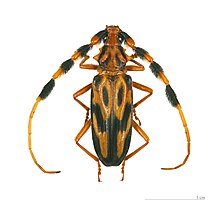Cerambycidae
| Cerambycidae | |
|---|---|

| |
| Batus barbicornis | |
| Klasifikasi ilmiah | |
| Kerajaan: | |
| Filum: | |
| Kelas: | |
| Ordo: | |
| Subordo: | |
| Superfamili: | |
| Famili: | Cerambycidae |
| Subfamili | |
|
8, lihat teks | |
Kumbang tanduk panjang (Cerambycidae) adalah famili kumbang. Hewan ini memiliki antena, yang biasanya lebih panjang dari tubuhnya sendiri. Tetapi, beberapa anggota famili ini memiliki antena yang cukup pendek, seperti spesies Neandra brunnea, dan spesies semacam ini sulit dibedakan dari famili kumbang lain seperti Chrysomelidae. Famili ini merupakan famili yang besar dan terdiri dari lebih dari 20.000 spesies yang telah dideskripsikan, dengan lebih dari separuhnya hidup di bumi belahan timur. Beberapa spesies dalam famili ini merupakan hama. Larva spesies ini mengebor ke dalam kayu dan dapat menyebabkan kerusakan pada pohon atau kayu yang belum diolah. Beberapa spesies terlihat seperti semut, lebah, dan tawon, meskipun mayoritas spesies dari famili ini berwarna samar.
Klasifikasi
Seperti famili besar lainnya, beberapa pihak cenderung mengelompokkan famili ini ke banyak subfamili yang berbeda, atau terkadang memisahkan beberapa subfamili menjadi famili tersendiri (seperti Disteniidae, Oxypeltidae, dan Vesperidae)[2], sehingga terdapat beberapa kontroversi mengenai dasar-dasar pengelompokan Cerambycidae.[3]
Subfamili
Ada delapan subfamili: [4]
- Cerambycinae Latreille, 1802
- Dorcasominae Lacordaire, 1869
- Lamiinae Latreille, 1825
- Lepturinae Latreille, 1802
- Necydalinae Latreille, 1825
- Parandrinae Blanchard, 1845
- Prioninae Latreille, 1802
- Spondylidinae Audinet-Serville, 1832
Catatan kaki
- ^ "Cerambycidae Latreille, 1802". Integrated Taxonomic Information System. Diakses tanggal June 6, 2011.
- ^ Sergio Antonio Vanin & Sergio Ide (2002). "Classificação comentada de Coleoptera". Dalam C. Costa, S. A. Vanin, J. M. Lobo & A. Melic. Proyecto de Red Iberoamericana de Biogeografía y Entomología Sistemática PrIBES 2002 (PDF). Monografias Tercer Milenio (M3M) (dalam bahasa Portuguese). 3. hlm. 193–206. ISBN 84-922495-8-7.
- ^ Miguel A. Monné (2006). "Catalogue of the Cerambycidae (Coleoptera) of the Neotropical Region. Part III. Subfamilies Parandrinae, Prioninae, Anoplodermatinae, Aseminae, Spondylidinae, Lepturinae, Oxypeltinae, and addenda to the Cerambycinae and Lamiinae" (PDF). Zootaxa. 1212: 1–244. ISBN 1-877407-96-8.
- ^ Patrice Bouchard, Yves Bousquet, Anthony E. Davies, Miguel A. Alonso-Zarazaga, John F. Lawrence, Chris H. C. Lyal, Alfred F. Newton, Chris A. M. Reid, Michael Schmitt, S. Adam Ślipiński, Andrew B. T. Smith (2010). "Family-group names in Coleoptera (Insecta)". ZooKeys. 88: 1–972. doi:10.3897/zookeys.88.807. PMC 3088472 . PMID 21594053.
Pranala luar
- (Prancis) Base de données Titan sur les Cerambycidés ou Longicornes
- Gallery Photo gallery of worldwide long-horned beetles
- Photo gallery "Longhorn beetles (Cerambycidae) of the West Palaearctic Region"
- CDFA Cerambycidae of the New World
- Cerambycidae of French Guiana
- National Museu, Rio, Brazil Holotype images
- Iberodorcadion Coleoptera, Cerambycidae, Dorcadion - RedIRIS
- VIDEOS - Longicornes (Dorcadion, Cerambycidae,Coleoptera)
- Cerambycidae of Borneo pdf
- BugGuide.net - Longhorned Beetles (Cerambycidae)
- Anoplophora chinensis, citrus longhorned beetle on the University of Florida / Institute of Food and Agricultural Sciences Featured Creatures website
- Coleoptera: Cerambycidae, University of Florida, Dept. of Entomology and Nematology
- Wood-boring beetles of the World
Templat:Link GA Templat:Link FA Templat:Link FA Templat:Link GA